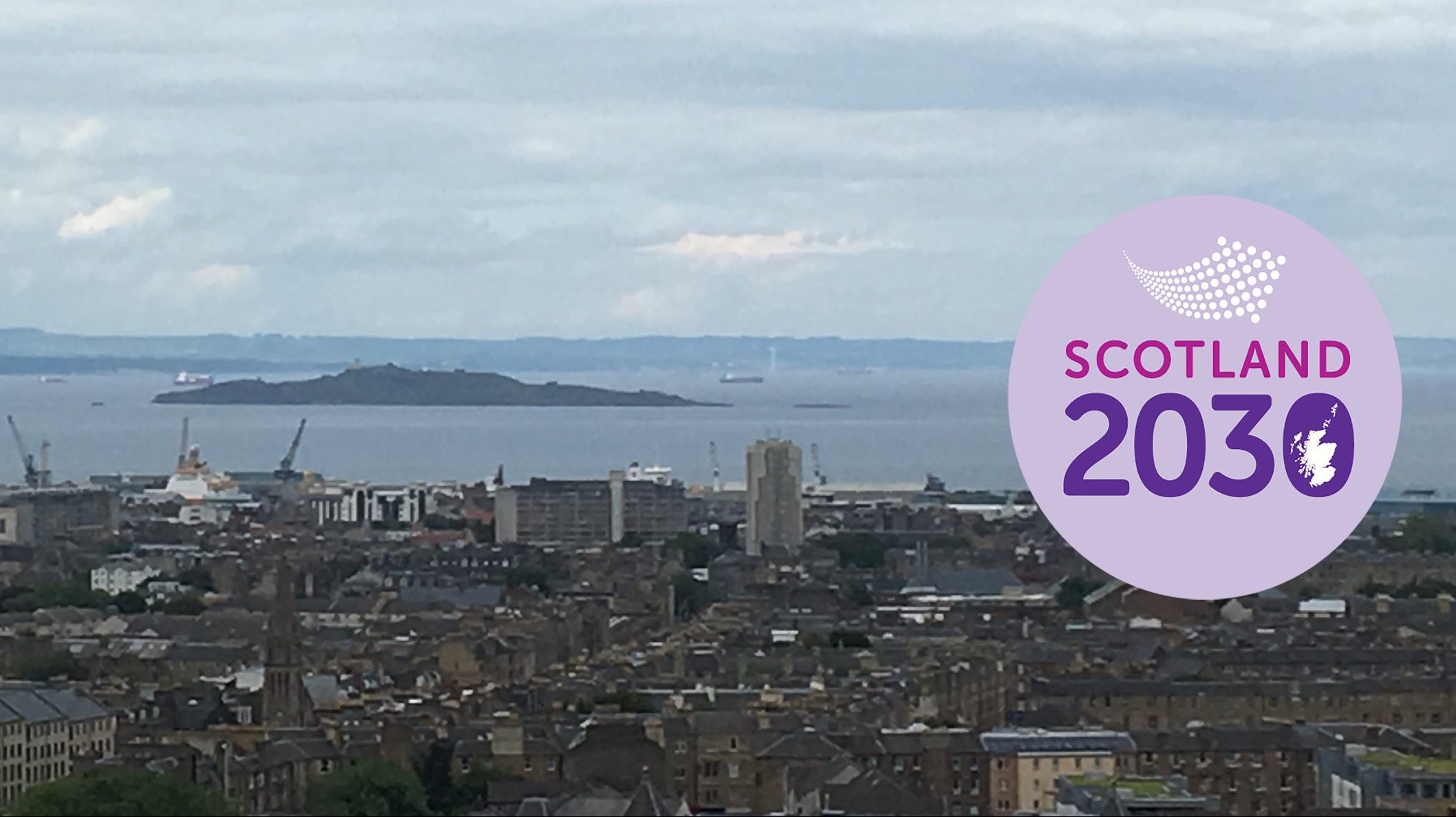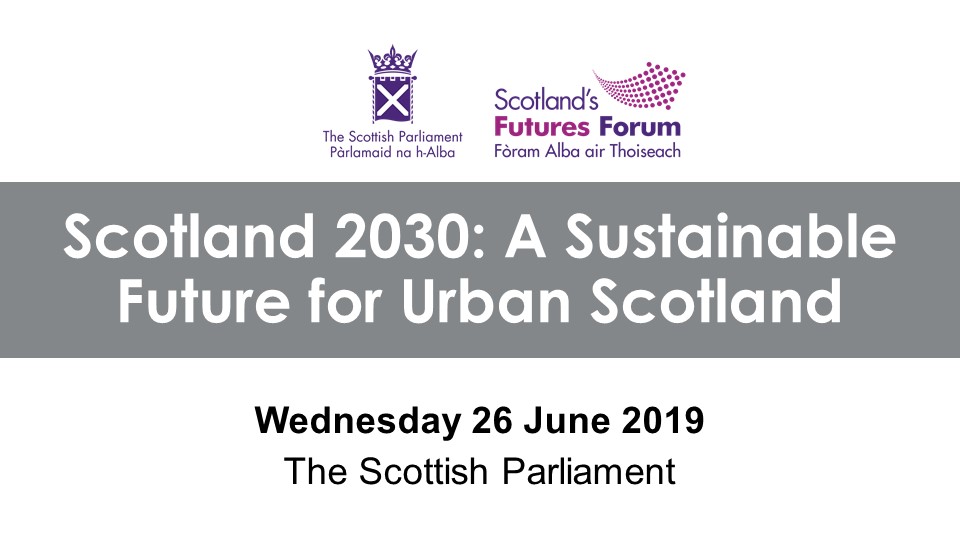Scotland 2030: A Sustainable Future for Urban Scotland
Wednesday 26 June 2019, at the Scottish Parliament
Life in Scotland’s towns and cities is forecast to change significantly in the coming decades. Cities are set to continue to grow, facing the challenge of providing housing and services for new populations, while the role and place of towns in Scotland remains uncertain as traditional high streets disappear and services are increasingly centralised.
With these predicted changes likely to offer both opportunities and challenges, what role is there for communities in the regeneration of urban Scotland? What successes can we learn from within Scotland, and how can we build sustainable communities for the future?
These questions and more were considered by an expert panel at a Futures Forum event on 26 June 2019, chaired by Stuart McMillan MSP. They discussed the challenges and trends, explored the potential futures ahead of us, and considered the outcomes we want to achieve by 2030.

Highlights video
Podcast
Listen to a highlights podcast of the event
Written report
Panel
Andy Milne
Andy is chief executive of Scotland’s Regeneration Forum (SURF), which works to improve the lives and opportunities of residents in Scotland’s disadvantaged communities.
Andy presented on the role of communities in regeneration and shared his vision of a sustainable future for urban Scotland.
Jemma Neville
Jemma leads the Voluntary Arts Scotland team, which promotes participation in creative cultural activities across the country. She is also a Board member of the Citadel Youth Centre in Leith, and is the author of a forthcoming memoir, Constitution Street, published by 404 Ink in September, about human rights on one street in Edinburgh.
Andrew Bowman
Andrew is Head of Business Investment and Operations at Riverside Inverclyde, the Urban Regeneration Company set up to deliver long-term economic growth in Inverclyde. He is also Chair of Developing The Young Workforce West region, the Junior Vice-President of Inverclyde Chamber of Commerce, co-founder of Creative Inverclyde and the founder of Taste Inverclyde, a vehicle to support food and drink businesses.
Presentation
Andy Milne, Scotland’s Regeneration Forum
Andy opened his presentation by remarking that although we don’t know what the future holds, we have the opportunity to explore urban regeneration five to ten years hence if we look at demographic and political trends. Before sharing his vision, he summarised recent Scottish Government policy and provided an overview of the challenges and opportunities we currently face in this area.
Government policy presently has a focus on three key areas: empowering communities; places and towns; and investment through the regional and city deals. The increasing emphasis on ‘place’ was welcomed by Andy along with the recognition that there needs to be a greater community-led approach. That recognition led to the legislation on land reform and community empowerment.
The stronger emphasis on towns is also to commended. The Town Centre First Principle, which emerged from a national review of town centres, encourages any new investment to be tested against its impact on the town centre, while the Place Principle has encouraged national agencies like Scottish Enterprise and Scotland’s Futures Trust to consider how any investment or infrastructure will support communities, and connect communities, people and places.
Although all these developments are to be welcomed, Andy highlighted a number of challenges facing community-led regeneration, starting with his view that it has been ‘overstated and underfunded’. He argued that if we want communities to take responsibility for regeneration then adequate support needs to be in place to make that a meaningful reality.



Projects that are genuinely community-led are quite rare and Andy warned that we need to be realistic about what can be achieved: if we don’t get this right, we are in danger of damaging the concept of community-led regeneration.
Andy went on to raise concerns that the lack of a level playing field means that funding for regeneration tends to gravitate towards where the market is already operating or to wealthier communities, with the result that such resources are in danger of inadvertently increasing rather than addressing inequalities. Similarly, he suggested, it was reasonable to criticise city deals for overlooking the fact that Scotland is a nation of towns, which is where 70% of the population live.
Andy went on to discuss some of the opportunities for greater community involvement in urban regeneration, including a genuine return to ‘place’. The Scottish Government and other agencies are now connecting the Place Principle to wider policy. This has led to more place-based approaches, including exploring how assets can be used to engage communities.



In addition, SURF has been fully supportive of creativity and heritage as a means of offering a way for communities to get involved in urban regeneration. Although Scotland has historically not been good at genuine community empowerment, Andy pointed to good examples, such as Audit Scotland’s initiative which is looking to community empowerment to enhance local service delivery and to get feedback on local services. He went on to say that given the size of local authorities it is unreasonable to expect them to know what is going on in every community, although IT may be able to help with this in the future.
Andy also highlighted good examples of: large-scale regeneration (Clyde Gateway and Dundee Waterfront); town centre regeneration (Lochgelly and Kilmarnock); as well as lots of community-led regeneration projects.
However, to realise some of the current opportunities around community engagement, Andy suggested that various challenges had to be recognised and addressed including: rising inequality; more low paid and service based work; the loss of work to technology; and challenges related to old age and social care.
Andy closed his presentation by sharing his vision of regeneration in the future, in which it is likely we may have complementary regional specialism (rather than one national strategy). His hope was that we would build on the great work being undertaken in Scotland in ecological sciences and engineering to support the green growth we need and that this would be complemented by wellbeing economy approaches which would reconnect individuals to their community, supported by free public transport, wage solidarity and an accessible and participative local government.

He did, however, caution about how recent political history, particularly in America, can show that the context for our decisions can change radically. Looking to the future, we should expect the unexpected.
Responses
Jemma Neville, Director of Voluntary Arts Scotland
Jemma started her response by questioning what we mean by a community, particularly when we talk of community empowerment. Voluntary Arts Scotland has been exploring the concept of a ‘commons’, which they ideally see as a place-based community, like a street, roughly the size of 150 to 200 people who, because of their physical proximity, have a natural empathy and shared sense of care for their place.
In Jemma’s view, this concept is of particular interest to the cultural sector because exciting things happen at a local level when you lean into the arts. In this context, she highlighted how our cultural roles are most active when they are very local, for example participation in local choirs.
There are already strong examples in Scotland of a commons approach flourishing in the arts sector, such as the Stove Network which through the process of transforming a high street has reclaimed it as a civic space. Jemma argued that we need to build on these examples by strengthening our networks and our cultural infrastructure so we have more accessible and affordable venues, whether they be parks or libraries, for more civil and self expression.
Jemma’s hope for the future is that by leaning into the arts and connecting up the local we can link up streets, cross national boundaries and address the realpolitik that has caused so much of our current anxiety.

Andrew Bowman, Head of Business Development at Riverside Inverclyde Urban Regeneration Company
Andrew reflected on the experience of regeneration in Inverclyde, where £30 million has been spent on regeneration in the last 12 years. Since the decline of the shipbuilding industry, the area has lost a significant proportion of its population and has a high percentage of over 75-year-olds.
The financial crash meant that much of the cash promised at the start of the regeneration project to bring in investment and jobs did not materialise. Despite that, Andrew said, the project has seen great pockets of success led either by individuals or by statutory agencies. He highlighted how there is now a stronger emphasis on collaboration to help these initiatives feel less siloed and on fostering stronger foundations to ensure projects survive the loss of key individuals.
The agency recognises that its focus on repopulation cannot just be about building houses but must also look at attracting businesses and the private sector to the area to bring in the jobs that will stop the area being merely a commuter belt for Glasgow.
Discussion

Local accountability
With power in Scotland, even at local authority level, still very centralised, much of the discussion focused on the need to address the power imbalance between councils and communities.
However, it was agreed that the concept of a community is problematic which in turn makes it challenging for local authorities to undertake engagement, particularly as local authorities need to work with people who have good communications skills and can compromise.
Questions were raised around: who the community is; who is best placed to represent a community; and how decisions can be balanced to represent different parts of a community. With a recognition that community led projects would benefit from better engagement rather than a carrot and stick approach, it was suggested that there should be a place for technology to engender better participation especially from children and young people.
Participatory budgeting was discussed as an initiative that had offered a huge step forward in terms of bringing people together at a local level to discuss their priorities. However, for participatory budgeting to realise its full potential, it was felt the initiative needed to move beyond a tokenistic project-based approach.
As part of this discussion, it was suggested that when undertaking economic modelling, local authorities could look to the Preston Model, which has used the purchasing power of statutory agencies to boost local businesses and social enterprise start ups to retain more public money within the local community.
It was also suggested that, although we have community empowerment and land reform legislation, most communities don’t actually want to own community assets: they want to know who owns them and what they are being used for, and to have a say in their use.
Town and city development
It was agreed that, while constant development is not necessarily a good thing, neither is all development bad, with many bringing much needed training and jobs to deprived communities. However, any perceived benefits will depend on the views of the individuals who have to live with the new development.
Dunfermline’s Heritage Quarter was cited as an example of a good development, along with the recent investment in Paisley’s town centre, which has seen the archives and gallery relocated to the former Littlewoods shop on the high street, along with the library.
Within this context, it was noted that a number of recent town developments have thrown up issues around the design and use of shared spaces. For example, the establishment of trees and flower beds in town centres, along with cycle lanes, has caused health and safety issues for those with disabilities or young children.
Similar issues have arisen in some new housing developments which have been designed without pavements. While there are different views on shared spaces, it was suggested that technology should be good enough to find mediated solutions.
At a macro level, there are still real challenges around developments gravitating to where the market is already operating, and with the fact that developments in many wealthy communities generally face strong resistance while people in disadvantaged areas do not have a voice to support the change or development they need.
It was suggested that we need to be prepared to learn lessons from the first City Deal (in Glasgow) so that the others fully exploit any opportunities and are equipped for challenges that are not yet apparent.
Changing demographics
Regeneration and planning need to take account of Scotland’s shifting demographics, including the population drift from the West to the East, and of an increasingly elderly population with greater health and social care needs.
It was also noted that in Scotland’s cities, around a third of children are born to mothers born outside of the UK, and that little is known about this group, such as how long they are likely to stay in Scotland, what services they require and in what languages.
It was suggested that there is a danger of being complacent about this issue, particularly as many migrants tend to live in more disadvantaged communities, with the upshot that any concerns or perceptions about services being put under strain need to be recognised and addressed to prevent immigration becoming an issue that plays into the hands of populist politicians.
It was noted that there is currently an opportunity to engage with a consultation on the next census which will offer more detail on Scotland’s current population.
Within the discussion on immigration, it was suggested that the arts is a great way to bring people from different backgrounds together, engender a stronger understanding of different cultures, and to give people a greater sense of dignity. Generally local, rather than national, arts organisations are better placed to work in this space and, as a result, it was felt such initiatives should be genuinely community-led.
Vision for the future
Although we don’t know the needs of the future, it was suggested that we should be developing our towns and communities so that people don’t feel the need to uproot and move their families to follow their dreams.
One of the grounds for optimism put forward was the fact that a lot of people care about their communities and their sense of place. It was noted that we need to recognise that no one has the right answer on urban development and that, more than ever, we need to be prepared to learn and say when mistakes have been made, and to listen and compromise.







